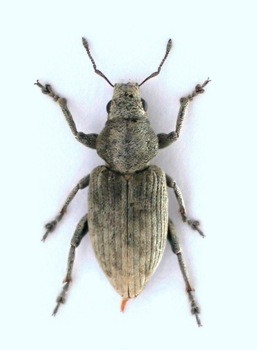Pests
Tanymecus dilaticollis Gyll. - Maize Leaf Weevil (Southern Gray Weevil).
Systematic position.
Class Insecta, order Coleoptera, family Curculionidae, genus Tanymecus. Differs from Tanymecus palliatus by spread-out sides of pronotum.Biological group.
Polyphagous pest of maize, sunflower, and beet.Morphology and biology.
Body length, 5.1-9.6 mm. Pronotum with pre-basal constriction, postocular lobes of pronotum with row of long rigid hairs. Body densely covered with gray scales and short subrecumbent setae. In spring about 90% of adults appear on the soil surface 3 weeks after average air temperatures increase to 10°C. Flight begins in the middle of May when temperatures are between 29-34°C. Adults need additional feeding before reproduction. Mating continues from early spring to the middle of June. Females lay eggs one by one in the soil at a depth of 2 cm. Fertility is about 150-350 eggs. Eggs develop 10-12 days at a temperature of 20°C. Larvae live in the soil at a depth of 20-60 cm, eating roots of maize, sunflower, winter wheat, oat, barley, and couch-grass. Larva has 4 instars which take 2-3 months to develop. Body length of the last instar larva is 9.6 mm. Pupation occurs in soil cradles at a depth of about 60 cm from mid-July to mid-September. Young adults hibernate in soil cradles.Distribution.
Inhabits Slovakia, Hungary, Romania, Bulgaria, former Yugoslavia, Greece, Turkey, Syria, Iraq, Iran. In the former USSR it is distributed in the southern parts of Moldavia and Ukraine, in the Rostov Region, and in the Caucasus.Ecology.
Monovoltine through out range. Widely distributed in plain, but no higher than 400 m above sea level. Adults occur from the end of March - beginning of April to June. Polyphage, feeds on plants of 70 species. Overwintered adults start feeding on weeds and winter wheat and then migrate to young crops of oat, barley, beet, sunflower, and maize. Feeding intensifies as temperature increase to 20°C and more. Maize provides the most favorable conditions for rapid development of larvae. Larvae develop at a soil humidity no less than 10%.Economic significance.
Harmfulness of Tanymecus dilaticollis has increased in the last 40 years in the European part of the former USSR. Adults are more dangerous during the early phase of development shoot, larvae are not significant. They consume leaves margins and destroy apical meristems. Control measures include limiting maize production to 2 or less years in a crop rotation. Maize and sunflower are necessary to alternate with cereals in crop rotation.Reference citations:
Dieckmann L. 1983. Contributions to the insect fauna of the GDR: Coleoptera - Curculionidae (Tanymecinae, Leptopiinae, Cleoninae, Tanyrhynchinae, Cossoninae, Raymondionyminae, Bagoinae, Tanysphyrinae). Beitrage Entomologie, Berlin, 33(2): 257-381. (In German)Goncharenko L.G. 1964. Morphological and biological peculiarities of the larvae Tanymecus dilaticollis Gyll. (Coleoptera, Curculionidae). Zoologicheskii zhurnal 43(5):774-776. (In Russian)
Goncharenko-Popova L.G. 1967. Ecological causes of different population density of Tanymecus dilaticollis Gyll. in fields of crop rotation. Zoologicheskii zhurnal 46(2):221-228. (In Russian)
Kopaneva L.M., ed. 1980. Key to harmful and useful insects and ticks on grain plants in the USSR. Leningrad: Kolos. 335 pp. (In Russian)
Minoranskii V.A. 1976. Insect pests from beet fields. Rostov: Rostovskii Univesrity. 112 pp. (In Russian)


